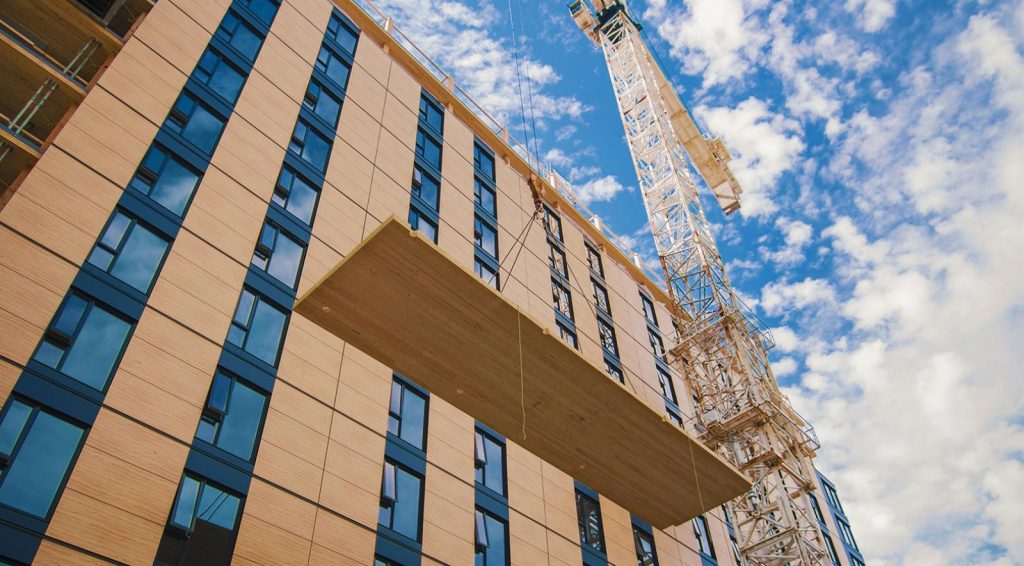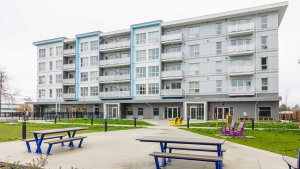B.C. wood builders and product manufacturers are applauding the province’s push to grow its mass timber industry.
Recently, government officials appointed Ravi Kahlon, the parliamentary secretary for forests, lands, natural resource operations and rural development, to spearhead the expansion and use of mass timber in construction. Kahlon will work with stakeholders to build new markets for mass timber products to assist the province as it plans to rebuild the economy in the wake of COVID-19.
“It is very significant anytime that you get an impetus from government to help promote and support a nascent industry,” said Hardy Wentzel, CEO of Structurlam. “It really says that government is fully on board and behind this, which the B.C. government always has been.”
Headquartered in Pentiction, Structurlam is one of North America’s leading manufacturers of mass timber solutions including cross laminated timber, glulam beams, industrial matting and other products. They have been a key part of some of the Pacific Northwest region’s most prominent mass timber projects including Brock Commons at the University of British Columbia and Carbon12 in Portland.
Wentzel said Structurlam has altered day-to-day business during the pandemic to ensure workers are safe and can follow provincial guidelines but are continuing to produce wood products. He was hesitant to speculate on how the construction industry could change after COVID-19.
“Right now, we have to be careful. I think we are placing a lot of weight on this idea that the world will never be the same,” said Wentzel. “Let’s have this conversation once we have an effective vaccine.”
Wentzel said he is hopeful that once COVID-19 is conquered, the industry can resume the in-person collaboration it needs to solve complex problems.
While the province has opened the door for wood structures by doing things like altering the building code, Wentzel said one of the main barriers to mass timber construction is fear.
“Nobody likes to be the guinea pig,” he said. “These architects and designers have been making buildings using traditional concepts for 20 years successfully and they might be reluctant to learn a new way of doing things.”
But Structurlam is now seeing clients like Walmart, Microsoft and Google all getting on board with the potential of mass timber for various projects.
“These iconic brands are seeing the sustainability benefits and the biophilic benefits,” he said.
One of the early adopters of mass timber construction has been Adera Homes. The company developed its own proprietary floor system called Quiet Home and it is a shareholder in Structurlam. The floor joist system uses dense cross-laminated timber to drastically reduce airborne sound and impact sound.
“We believe that wood is the better way,” said Eric Andreasen, vice-president of sales and marketing for the builder. “It’s the oldest method of buildings for humans. With technology advantages and engineering, the sky’s the limit.”
The company’s foray into mass timber took off in 2017 with its condo project Virtuoso, at the University of B.C.
Prefabricated panels allowed them to minimize people and time at the site. And Adera noted that its wood framing efficiency increased by about 30 to 40 per cent. The company is now thinking about post COVID-19 trends, imagining how wood products can help more people comfortably work from home.
“There were some concerns because when it comes to consultants, like architects and engineers, they are all geared for traditional methods of building,” said Andreasen. “That was one of the challenges, just finding people willing to work with us and find out how to do this but we have managed it.”
Andreasen encouraged others in the industry to take the plunge and start building with mass timber products.
“This is the future,” he said. “It’s sustainable and could be one of the only things in our industry to significantly slow down or reverse climate change because it sequesters carbon, is locally sourced and locally made in B.C. for B.C.”
Follow the author on Twitter @RussellReports.











Recent Comments
comments for this post are closed